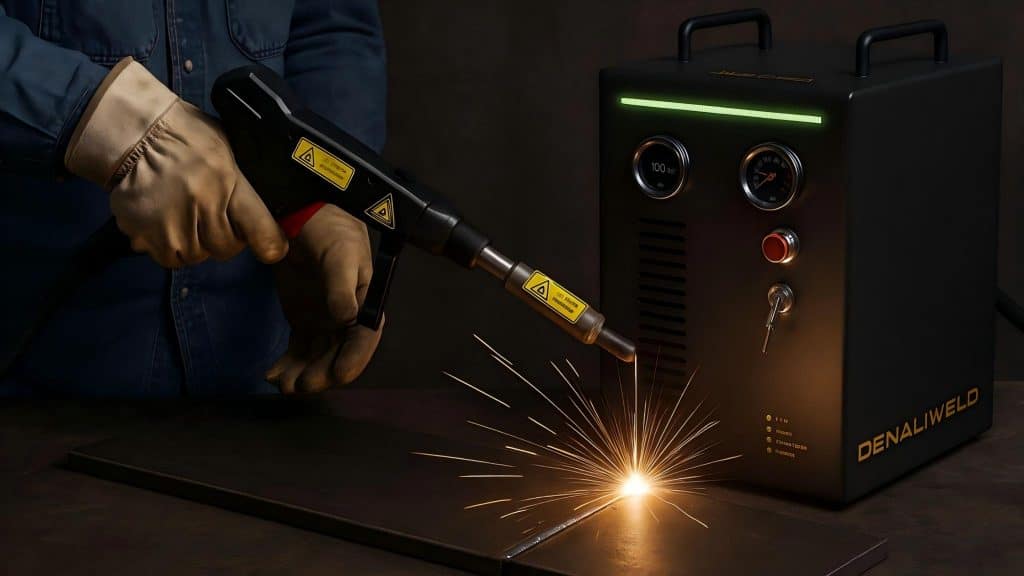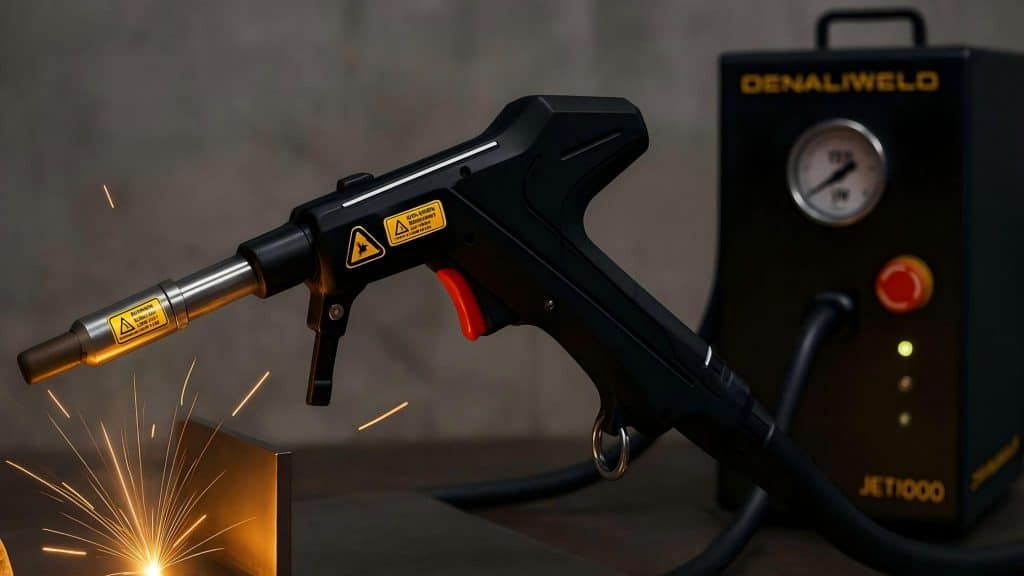
Handheld laser welders are one of the most recent innovations in welding technology. Many manufacturers hail their ability to boost output volume and fast-track production time. They can also quickly turn unskilled workers into competent welders.
However, handheld lasers are not cheap. So, it is smart to ask whether this technology is worth a try. In this article, we address the question “Are handheld laser welders any good?” to help you make the right decision.
Comparing Handheld Laser Welders to Traditional Welding Methods
MIG and TIG are some of the old-school welding methods used by many. These techniques use an electric arc to melt and combine metals.
In contrast, a handheld laser welder fuses metals using a highly concentrated laser beam from a fiber or solid-state laser source.
In terms of welding speed, handheld laser welders beat the traditional methods. The intensity of the focused laser beam can weld 5 to 10 times faster than TIG. Estimates show that laser welding can penetrate metals at a stunning rate of 0.5 to 1.5 meters per minute, depending on the material’s thickness.
Such impressive speed of handheld laser welders translates to higher production volume and shorter turnaround time compared to the traditional methods.
Moreover, handheld laser welders generate a smaller heat-affected zone (HAZ) because of their focused beam that hits a particular area with high precision. For this reason, laser welds usually have minimal thermal distortion and adopt the parent material’s inherent metallurgical properties without impurities.
On the other hand, MIG and TIG have extensive thermal effects on the material due to their larger HAZ. This often leads to alterations in the metal’s microstructure through phase transformation and recrystallization, resulting in weaker welds.
But to fully maximize the edge of handheld laser welders over traditional methods, it is crucial to choose the right machine for your needs.
Consider Denaliwed’s JET 1000 Micro Laser Welding Machine. It is a handheld laser welder with faster speed, higher precision, and smaller HAZ compared to traditional welding techniques. The JET 1000 is a lightweight and portable machine, weighing only 48.5 pounds (22 kg), that can operate continuously in a wide temperature range of -10°C to 45°C (10°F to 110°F) in diverse environments. Equipped with an advanced laser control system, JET 1000 can deliver high output power at safe ranges and achieve a smooth and superior output curve.
What are the Advantages of Handheld Laser Welding?

It is no secret that a handheld laser welder costs a substantial amount. Yet, it is a worthwhile investment in the long run because of the multitude of benefits it offers, such as:
Unmatched Portability and Flexibility
This machine is lightweight, so it is easy to carry, maneuver, and set up anywhere on the site. Even in complex assemblies with awkward or tight spaces, you can fit the machine and perform the welding with a handheld laser welder (as long as you have protective measures in place).
High-level Precision and Control
Most handheld laser welders come with software that allows you to adjust the laser’s parameters. You can control the beam’s angle and intensity through buttons or knobs. This enables you to target a specific area with the correct temperature and precision that generates small HAZ.
Ultra-Speed and Efficiency
Produce more in less time. The laser’s concentrated beam penetrates inches of metal in seconds, which enables quicker production of welds. This fast-tracks your production process and boosts your output volume.
Reduced Post-Processing
Laser welding creates small HAZ, ensures minimal heat distortion, and produces cleaner welds. Hence, manufacturers may skip post-processing procedures like polishing or grinding. This means shorter production time and saving the company’s resources.
Versatile Welding Approach
From metals to thermoplastics,laser welding can fuse thin and thick workpieces. Even dissimilar metals can be combined with handheld laser welders because of their high energy concentration that prevents drastic distortion in the microstructure of both metals.
Maintenance and Operational Considerations
Compared to TIG or MIG, a handheld laser welder is low-maintenance. You can simply swipe and clean the accumulated dust on it and replace some parts every year. Furthermore, there is no daily consumable loss in laser welding because the beam delivers concentrated energy without excess heat.
Of course, the handheld laser welder must have reliable components to ensure its longevity. For instance, Denaliwed’s JET 1000 Micro Laser Welding Machine uses 100% U.S.-manufactured chips to ensure exceptional long-term performance and stability. This machine also passed the SGS, CE(MD, EMC), and WPQR certification, which guarantees its durability and reliable uptime in demanding work environments.
Cost-Benefit Analysis
A handheld laser welder typically costs $5,000 for basic models to $50,000 for high-end units. The cost may go higher if the machine comes with advanced features and controls.
In short, the cost of a handheld laser welder is no joke. Yet, the benefit it will deliver in the long term can help you minimize production costs and generate higher profits.
Here are some ways a handheld laser welder can drive overall production costs down:
- The impressive speed and efficiency of this machine enable you to rapidly produce more welds of higher quality.
- Handheld laser welders come with intuitive controls and simple setup procedures. So, it only takes a short training to accustom your workers to this technology.
- The smaller HAZ created by a handheld laser welder means minimal to zero heat distortion. Hence, you can ditch your post-production clean-ups and save time and money..
Denaliweld’s Air Cooled Laser Welding Machine is an example of handheld laser welders that can deliver impressive welding speed and precision, which helps you save precious time and resources. This machine generates higher output power while conserving energy and features an independently developed laser control software that precisely regulates laser output. You can also easily adjust all laser parameters for seamless operation and faster setup.
Ideal Applications for Handheld Laser Welders
Here are some industries that will most likely benefit from the features of a handheld laser welder.
- Automotive: For the production of high-integrity and durable car components. The laser’s precision can also help in attaining a design that promotes fuel efficiency and optimal performance.
- Aerospace: Effectively fuses common metals used in the aerospace industry, such as titanium and aluminum alloys. This ensures strong and consistent welds that meet flight and safety standards.
- Electronics: For the assembly of delicate and complex electronic components and circuit boards.
- Custom Fabrication: The laser welder’s high precision enables welding of joints with intricate geometries or design requirements.
Final Thoughts
A handheld laser welder is a reliable tool to produce high-quality, strong, and clean welds. It can deliver optimal welding power, speed, and precision that results in efficient welding procedures, faster turnaround time, and cost-effective outcomes in the long run.
If your company needs a seamless and user-friendly handheld laser welder, go to Denaliweld. We are a manufacturer of globally recognized laser welding solutions that meet the industrial production needs of automotive, aerospace, metal jobs, boatbuilding, and other industries. We strive to offer innovative products made by industry professionals and laser experts.
Choose Denaliweld today.



